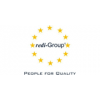SET Europa provides near shore, recruitment and outsourcing services and solutions for immediate project needs.
SET Europa ofrece servicios near shore, de contratación y externalización, así como soluciones para las necesidades inmediatas de los proyectos.
ABOUT
Our client company, based in Stuttgart (Germany), specializes in the design and construction of lightweight structures integrating architecture and engineering, based of scientific research and minimalistic forms in harmony with the ornamentation of buildings.
ROLE
The Head of the Engineering Department will lead the engineering team in designing, developing, and overseeing the construction of high-quality projects. This senior leadership role requires a strategic thinker with a strong technical background, excellent leadership capabilities, and a understanding of engineering principles, construction methodologies, industry standards and operational delivery of high-quality projects. The individual will ensure that all engineering projects are delivered on time, within scope, and on budget, while maintaining the highest levels of safety and sustainability.
RESPONSIBILITIES & REQUIREMENTS
1.Leadership and Strategy :
- Leadership : Lead, mentor, and manage a team of engineers, ensuring alignment with the company's vision, operational goals and objectives.
- Development : Develop and implement the department's goals, strategies, and key performance indicators (KPIs) to support overall company objectives.
- Collaboration : Collaborate with senior leadership, project managers, architects, and other departments to ensure engineering efforts are fully integrated with project needs.
- Continuous Improvement : Foster a culture of continuous improvement by encouraging feedback, innovation, and the sharing of best practices among team members and across departments.
2.Project Engineering Setup :
2.1 Client Briefing & Requirement Gathering :
Closely coordinate and support bid manager on project tenders.Attend initial client meetings to thoroughly understand their vision, functional requirements, budget, and timeline constraints.Act as or nominate the primary engineering expert during these discussions, translating complex client ideas into technical requirements and ensuring all key stakeholders are aligned.Lead the discovery phase by identifying client priorities (e.g., sustainability, aesthetics, durability) and incorporating these into the engineering strategy.2.2 Project Kick-Off & Engineering Workshops :
Organize and lead engineering kick-off meetings and workshops involving key stakeholders, including clients, architects, project managers, and regulatory representatives.Establish and assign key members of the delivery team for each project to allow the organization chart to be updated and all to be made clear of their responsibilities.Ensure that all parties involved have a shared understanding of the engineering objectives, technical limitations, and project constraints at the start of the project, to avoid miscommunication or scope changes later.Foster a collaborative environment where engineering solutions can be discussed and refined early on, preventing delays or costly redesigns further down the line.3.Project Engineering Setup :
3.1 Engineering Strategy Development :
Oversee all aspects of the engineering process, from initial concept development through final documentation and construction oversight.Collaborate closely with architects, project managers, and clients to define the engineering scope of each project from the onset, ensuring that technical and functional requirements are clearly established.Lead the development of the initial engineering concept, translating client requirements into workable engineered designs that align with the architectural vision, budget constraints, and regulatory guidelines.Guide the team in conducting feasibility studies and site assessments to identify potential challenges and opportunities, such as geological, environmental, or structural concerns, before the detailed design phase begins.Ensure that sustainability goals, including energy efficiency, environmental impact, and compliance with green building standards (e.g., LEED or BREEAM), are integrated into the initial design concepts.3.2Engineering Design Reviews :
Take responsibility for the preliminary design reviews, ensuring that all engineering disciplines (structural, civil, mechanical, electrical) provide qualified input and that designs are cohesive and feasible.Work with senior engineers and architects to evaluate design alternatives, considering cost, construction methods, materials, and client preferences, and advise on the best course of action.Ensure that all designs adhere to the latest building codes, safety standards, project specifications, and regulatory requirements, preventing costly redesigns or delays in later project phases.Make sure drawings are in line with project budget, scope and specification.Ensure any changes are recorded and managed.4.Collaboration with Architects & Designers :
Act as the primary technical liaison between the engineering team and the architectural design team, ensuring seamless integration of engineering solutions with the overall project vision.Proactively identify potential conflicts between engineering and architectural designs (such as structural or mechanical issues that could interfere with aesthetics) and work to resolve these during the early design stage.Engage in value engineering discussions, optimizing designs to meet budgetary constraints without sacrificing performance, safety, or functionality.5.Coordination of Detailed Design Packages :
Lead the team in preparing engineering design deliverables, such as deliverables schedule, initial layouts, drawings, calculations, and specifications for client approval using the company’s task allocation software.Ensure the creation of detailed technical documentation that provides a clear roadmap for construction teams, including load calculations, structural analysis reports, and mechanical or electrical system designs.6.Leadership and Strategy :
Leadership : Lead, mentor, and manage a team of engineers, ensuring alignment with the company's vision, operational goals and objectives.Development : Develop and implement the department's goals, strategies, and key performance indicators (KPIs) to support overall company objectives.Collaboration : Collaborate with senior leadership, project managers, architects, and other departments to ensure engineering efforts are fully integrated with project needs.Continuous Improvement : Foster a culture of continuous improvement by encouraging feedback, innovation, and the sharing of best practices among team members and across departments.7.Project Engineering Setup :
2.1 Client Briefing & Requirement Gathering :
Closely coordinate and support bid manager on project tenders.Attend initial client meetings to thoroughly understand their vision, functional requirements, budget, and timeline constraints.Act as or nominate the primary engineering expert during these discussions, translating complex client ideas into technical requirements and ensuring all key stakeholders are aligned.Lead the discovery phase by identifying client priorities (e.g., sustainability, aesthetics, durability) and incorporating these into the engineering strategy.2.2 Project Kick-Off & Engineering Workshops :
Organize and lead engineering kick-off meetings and workshops involving key stakeholders, including clients, architects, project managers, and regulatory representatives.Establish and assign key members of the delivery team for each project to allow the organization chart to be updated and all to be made clear of their responsibilities.Ensure that all parties involved have a shared understanding of the engineering objectives, technical limitations, and project constraints at the start of the project, to avoid miscommunication or scope changes later.Foster a collaborative environment where engineering solutions can be discussed and refined early on, preventing delays or costly redesigns further down the line.8.Project Engineering Setup :
3.1 Engineering Strategy Development :
Oversee all aspects of the engineering process, from initial concept development through final documentation and construction oversight.
Collaborate closely with architects, project managers, and clients to define the engineering scope of each project from the onset, ensuring that technical and functional requirements are clearly established.
Lead the development of the initial engineering concept, translating client requirements into workable engineered designs that align with the architectural vision, budget constraints, and regulatory guidelines.
Guide the team in conducting feasibility studies and site assessments to identify potential challenges and opportunities, such as geological, environmental, or structural concerns, before the detailed design phase begins.
Ensure that sustainability goals, including energy efficiency, environmental impact, and compliance with green building standards (e.g., LEED or BREEAM), are integrated into the initial design concepts.
8.2Engineering Design Reviews :
Take responsibility for the preliminary design reviews, ensuring that all engineering disciplines (structural, civil, mechanical, electrical) provide qualified input and that designs are cohesive and feasible.Work with senior engineers and architects to evaluate design alternatives, considering cost, construction methods, materials, and client preferences, and advise on the best course of action.Ensure that all designs adhere to the latest building codes, safety standards, project specifications, and regulatory requirements, preventing costly redesigns or delays in later project phases.Make sure drawings are in line with project budget, scope and specification.Ensure any changes are recorded and managed.9.Collaboration with Architects & Designers :
Act as the primary technical liaison between the engineering team and the architectural design team, ensuring seamless integration of engineering solutions with the overall project vision.Proactively identify potential conflicts between engineering and architectural designs (such as structural or mechanical issues that could interfere with aesthetics) and work to resolve these during the early design stage.Engage in value engineering discussions, optimizing designs to meet budgetary constraints without sacrificing performance, safety, or functionality.10.Coordination of Detailed Design Packages :
Lead the team in preparing engineering design deliverables, such as deliverables schedule, initial layouts, drawings, calculations, and specifications for client approval using the company’s task allocation software.Ensure the creation of detailed technical documentation that provides a clear roadmap for construction teams, including load calculations, structural analysis reports, and mechanical or electrical system designs.Collaborate with the project manager and planner to align the engineering design schedule with the overall project timeline, identifying key milestones for design development, client sign-offs, and regulatory submissions.11.Selection of Engineering Tools & Software :
Establish the use of design software platforms (e.g., AutoCAD, Revit, BIM systems) and ensure that engineering teams are aligned on the technological approach for project design. Keeping ahead of current market trends.Drive the adoption of cutting-edge tools such as Building Information Modeling (BIM) to ensure interdisciplinary coordination, reduce errors, and optimize designs before moving into construction.Collaborate with the project manager and planner to align the engineering design schedule with the overall project timeline, identifying key milestones for design development, client sign-offs, and regulatory submissions.12.Selection of Engineering Tools & Software :
Establish the use of design software platforms (e.g., AutoCAD, Revit, BIM systems) and ensure that engineering teams are aligned on the technological approach for project design. Keeping ahead of current market trends.Drive the adoption of cutting-edge tools such as Building Information Modeling (BIM) to ensure interdisciplinary coordination, reduce errors, and optimize designs before moving into construction.13.Risks and Opportunities Identification, Mitigation, and Development :
Lead the team in performing risk assessments at the outset of design, identifying potential technical challenges, budget risks, or site-specific issues that could affect the feasibility of the proposed design.Develop strategies to mitigate risks and to develop opportunities early, such as adjusting the design approach or proposing alternative materials or construction methods.14.Project Oversight :
Oversee the engineering aspects of all projects, ensuring timely delivery, quality standards, and compliance with safety and environmental regulationsManage project engineering budgets, schedules, and resources to optimize efficiency and performance.Ensure effective risk management in the engineering process, identifying potential technical risks and implementing mitigation strategies.15.Technical Expertise :
Provide high-level technical expertise in all engineering disciplines.Lead the development and implementation of engineering best practices, standards, and methodologies.Stay abreast of the latest industry trends, technologies, and regulations to maintain a competitive edge and ensure compliance with local, national, and international standards.16.Collaboration and Communication :
Foster strong relationships with clients, contractors, suppliers, and regulatory agencies.Work closely with the project management team to ensure engineering deliverables are aligned with project timelines and client expectations.Act as the key point of contact for all engineering-related matters during the lifecycle of each project.17.Quality Compliance :
Ensure that all engineering work is performed in accordance with regulatory codes, quality standards, and best practices.Implement continuous improvement initiatives to enhance efficiency, quality, and safety within the engineering department.Conduct regular reviews and audits of engineering designs, calculations, and construction practices to ensure quality control.18.Resource Management :
Develop, manage, and optimize the department’s resources, including human resources, software, and equipment.Identify and recruit top engineering talent to build and maintain a high-performing team.Oversee training and development programs for the engineering team to ensure skill growth and compliance with emerging industry standards.Manage resources work-package based in line with project deliverables and program.



















